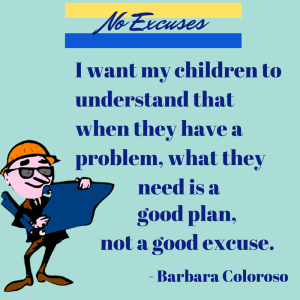 I got a lot out of Barbara Coloroso’s book, Kids Are Worth It. I took pages and pages of notes when I read it. The book is now full of underlines and margin notes.
I got a lot out of Barbara Coloroso’s book, Kids Are Worth It. I took pages and pages of notes when I read it. The book is now full of underlines and margin notes.
I never used to be able to write in my books. I didn’t want to mess them up. I wanted them to be in mint condition even after having read them. But having a nice looking book isn’t as important as having one that speaks to you and one you can interact with. So, I recommend making underline notes in pencil (you could always erase them later.)
Here are some of the notes I made and passages I highlighted as I read
Confrontations
- When you are upset or angry, say so in an upset or angry tone of voice
- Tell the other person about your feelings
- State your belief out loud but avoid killer statements
- Close the tip gap between the hurt and the expression of hurt. Give direct feedback
- State what you want from the other person
- Be open to the other person’s perspective on the situation.
- Negotiate an agreement you both can accept
It is important, that as teachers and parents we model working through problems the same way and take responsibility for our actions. These seven steps are quite handy and I am going to post them in my classroom.
Admit the Mistake and Take Responsibility
Coloroso uses the term “backbone parent” to show the contrast between two other parenting styles that are not effective. In the quote below she illustrates how backbone parents would handle making a mistake. It’s how I want my students to handle them to, so I altered the beginning a bit.
[A good person] admits that she made a mistake, takes full responsibility for making the mistake, avoids making excuses, figures out how to fix the problem created by making the mistake, recognizes if and how another person was affected, and figures out what to do the next time so it won’t happen again.
No Excuses
I want my children to understand that when they have a problem, what they need is a good plan, not a good excuse.
Here are another set of steps worth posting up.
6 Steps to Problem Solving
- Identify and define the problem
- List viable options for solving the problem
- Evaluate the options—explore the pluses and minuses for each option
- Choose one option
- Make a plan and DO IT
- Evaluate the problem and your solution. What brought it about? Could a similar problem be prevented in the future? How was the present problem solved?
Remember you are helping her learn how to think—not what to think.
The Game and The Sit
When two students have a problem with each other, there is no way a teacher can solve it. The problem often will spill out into the yard and become a fight or it will spark up again on the bus. Giving the students time to own the problem and figure it out is the best solution. I’ll admit that this particular method would be difficult in a classroom, but it is still worth considering.
Here are the basics (you can find out more in the book if interested)
“You both seem really angry. Come over here and sit together on the couch. You can both get up as soon as you give each other permission to get up. What is it you need to do?”
Asking this question is very important and good teaching practice before sending students off on any task.
“Don’t demand an apology. “I’m sorry” has to come from the heart, not the head. If you demand an apology, you’ll probably get one of two kinds: (a) whiny or (b) “I’m sorry” followed by the apologizer slugging the other kid again
Neither can move. They both have the power over the other, but that power is connected to the other person’s power. Kids begin to see that they are not dependent or independent but truly interdependent—not controlled or controlling but rather influencing and influenced. Soon one says,
“You can get up.”
“But I’m not going to let you get up.”
“You may both get up as soon as you give each other permission to get up”
Finally they get the message that together they have the power to control the situation. Notice that they haven’t been punished. The goal is not to punish them. It is to discipline them.
I still have more notes I can share with you about this book. And I picked up another Coloroso book at a used book sale last week, so I’ll probably have even more tips from her next year in this series.
Teaching Tip Tuesday – weekly advice and inspiration for teachers (over 200 entries so far)
One response to “You Need a Good Plan, Not a Good Excuse!”
[…] I got a lot out of Barbara Coloroso’s book, Kids Are Worth It. I took pages and pages of notes when I read it. The book is now full …read more […]